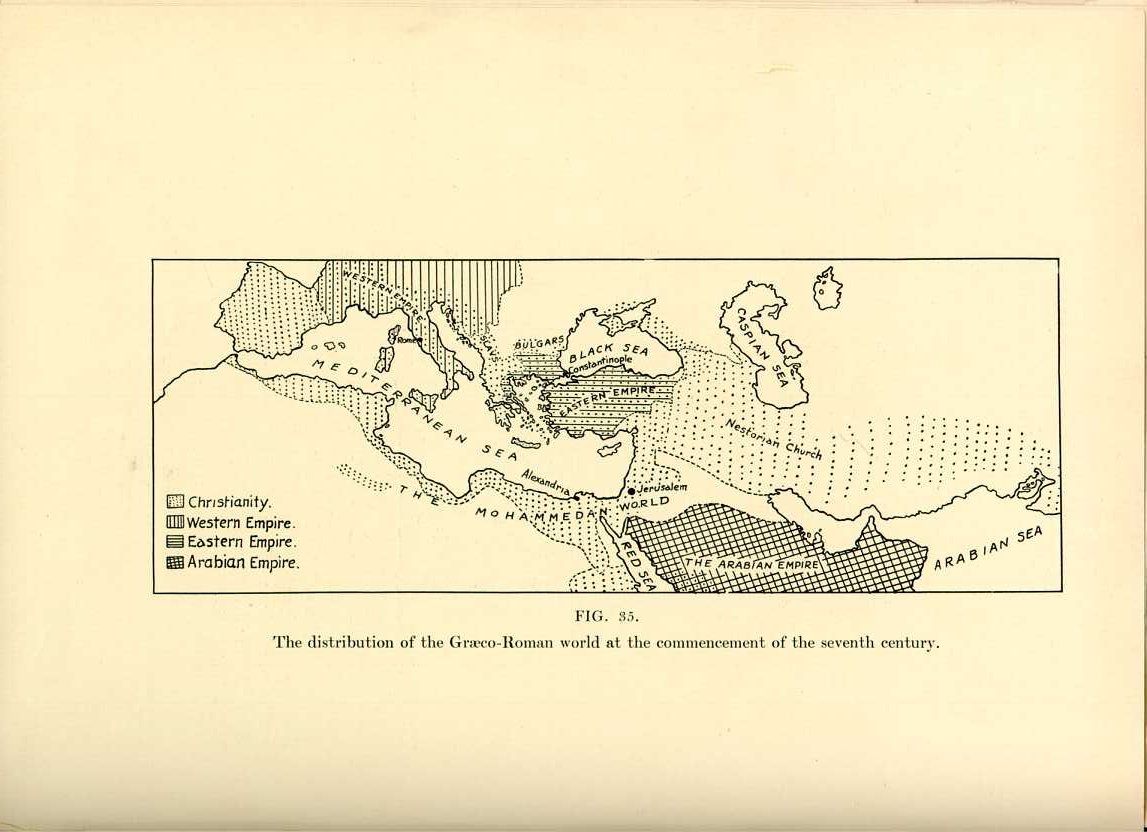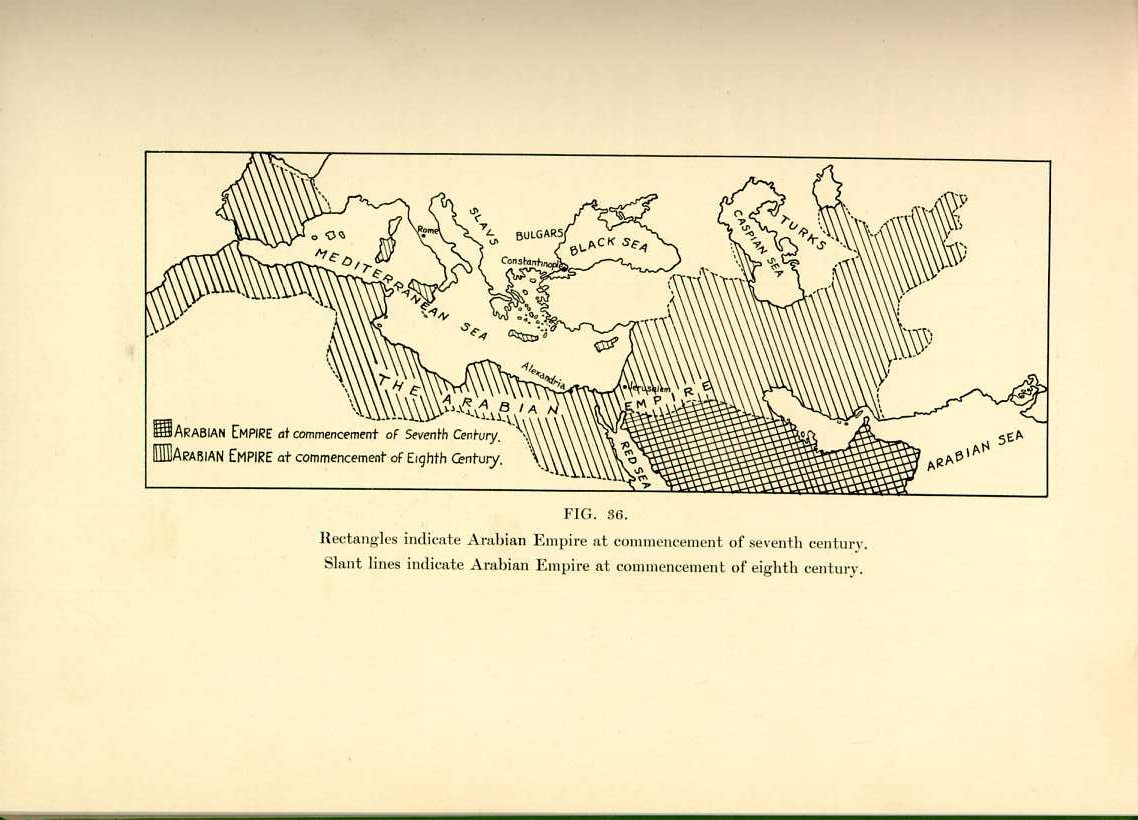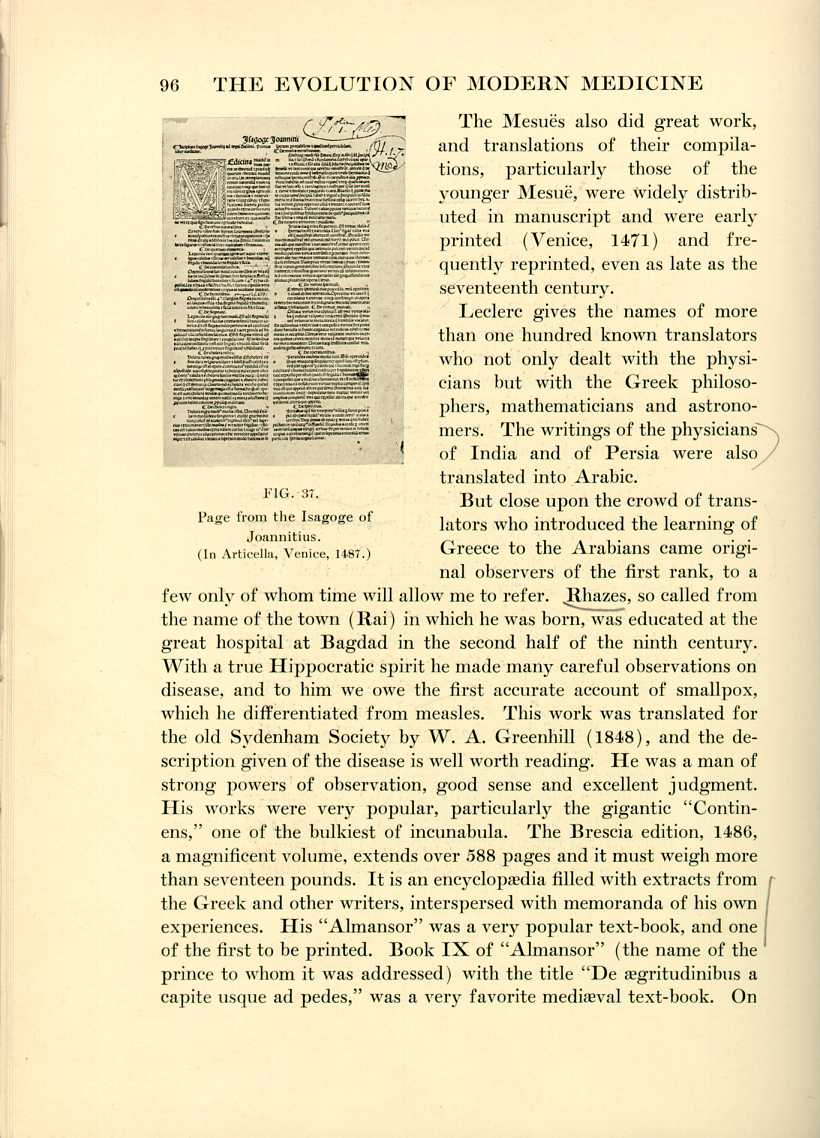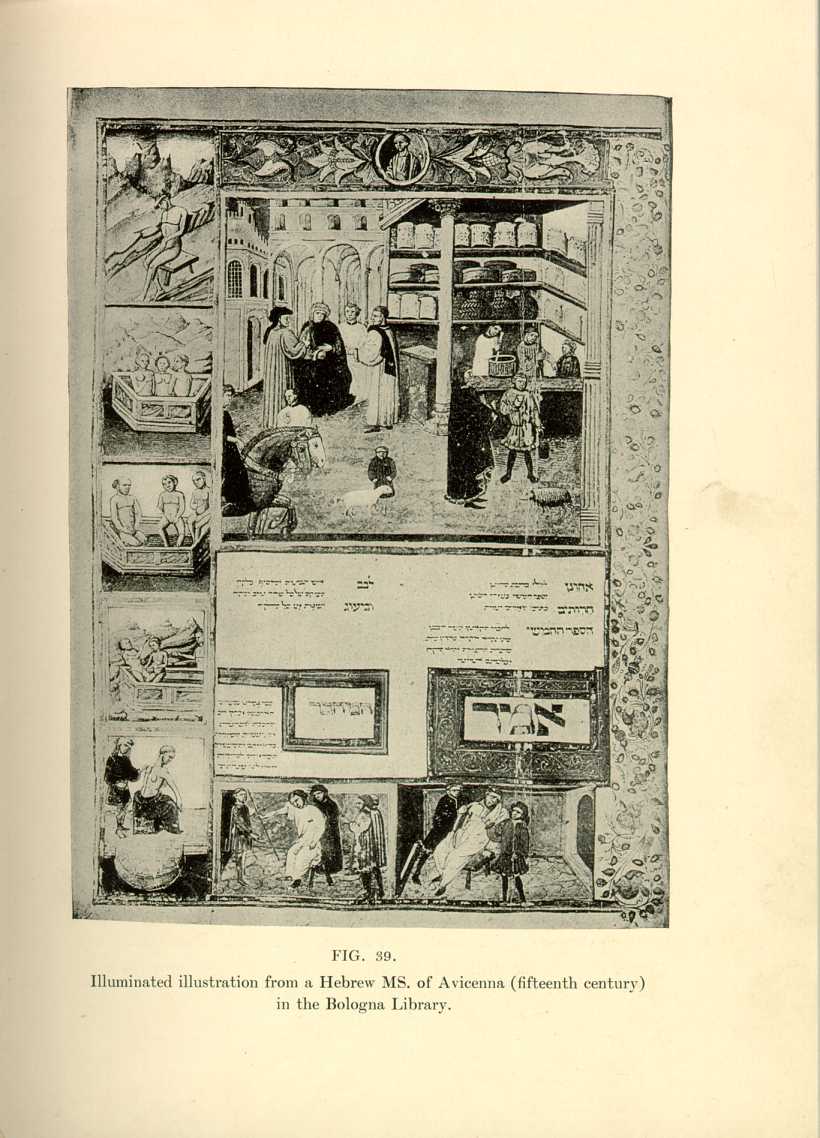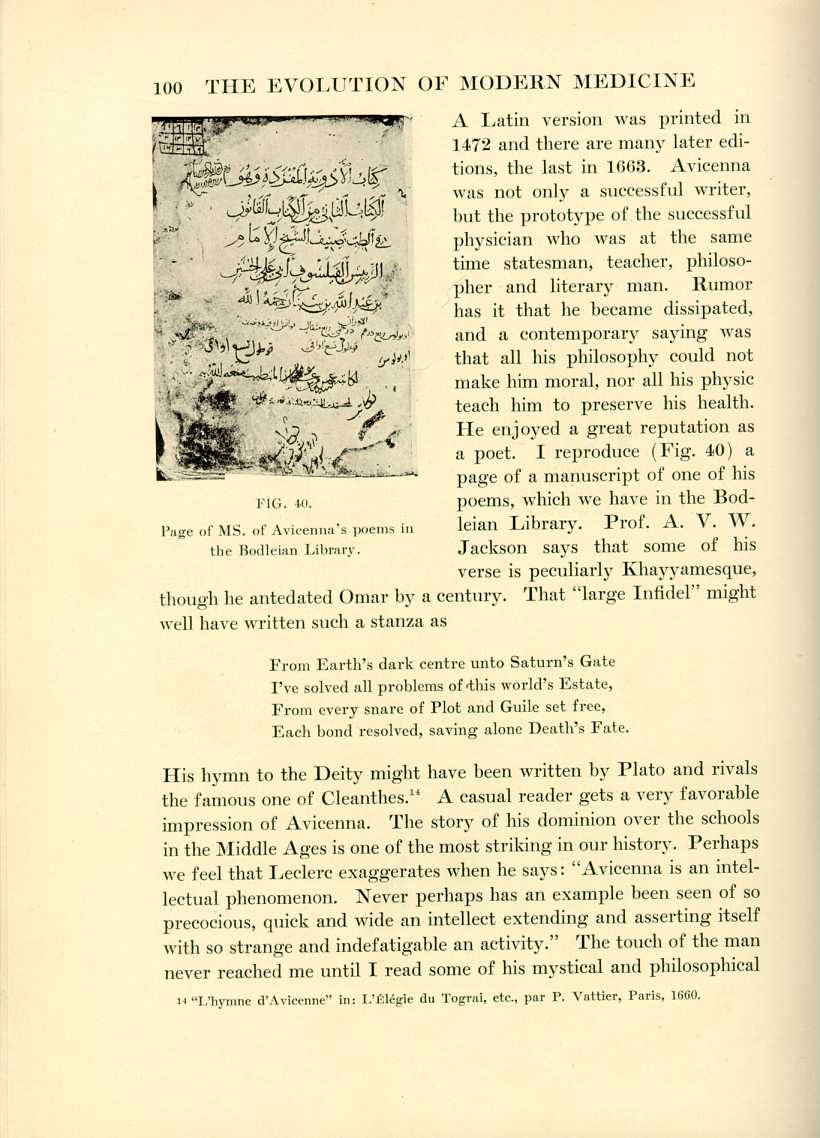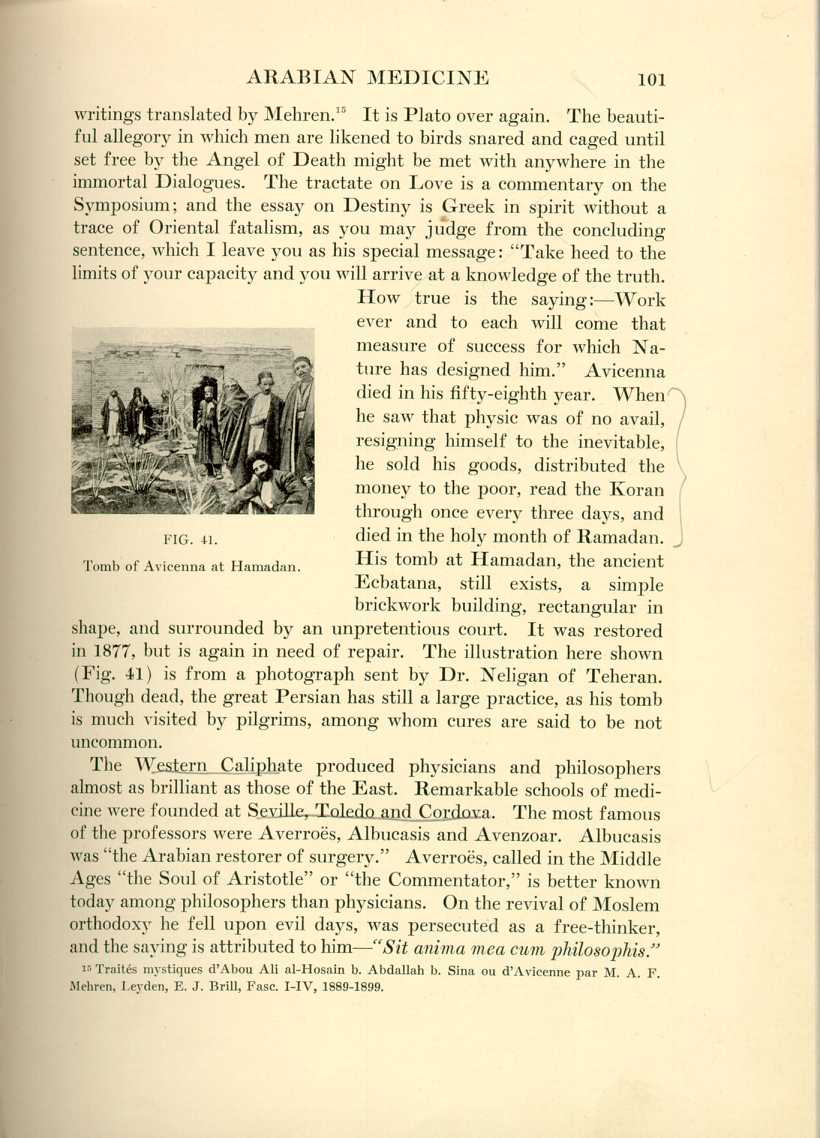| CHAPTER III The Evolution of Modern Medicine | ||
ARABIAN MEDICINE
THE third and by far the strongest branch of the Greek river reached the West after a remarkable and meandering course. The map before you (Fig. 35) shows the distribution of the Græco-Roman Christian world at the beginning of the seventh century. You will notice that Christianity had extended far eastwards, almost to China. Most of those eastern Christians were Nestorians and one of their important centres was Edessa, whose school of learning became so celebrated. Here in the fifth century was built one of the most celebrated hospitals of antiquity.
Now look at another map (Fig. 36) showing the same countries
about a century later. No such phenomenal change ever was made within so short space of time as that which thus altered the map of Asia and Europe at this period. Within a century, the Crescent had swept from Arabia through the Eastern Empire, over Egypt, North Africa and over Spain in the West, and the fate of Western Europe hung in the balance before the gates of Tours in 732. This time the barbaric horde that laid waste a large part of Christendom were a people that became deeply appreciative of all that was best in Græco-Roman civilization and of nothing more than of its sciences. The cultivation of medicine was encouraged by the Arabs in a very special way. Anyone wishing to follow the history of the medical profession among this remarkable people will find it admirably presented in Lucien Leclerc's "Histoire de la médecine arabe" (Paris, 1876). An excellent account is also given in Freind's well-known "History of Medicine" (London, 1725-1726). Here I can only indicate very briefly the course of the stream and its freightage.
With the rise of Christianity, Alexandria became a centre of bitter theological and political factions, the story of which haunts the memory of anyone who was so fortunate as to read in his youth Kingsley's "Hypatia." These centuries, with their potent influence of neoplatonism on Christianity, appear to have been sterile enough in medicine. I have already referred to the late Greeks, Aëtius and Alexander of Tralles. The last of the Alexandrians was a remarkable man, Paul of Ægina, a great name in medicine and in surgery, who lived in the early part of the seventh century. He also, like Oribasius, was a great compiler. In the year 640, the Arabs took Alexandria, and for the third time a great library was destroyed in the "first city of the West." Shortly after the conquest of Egypt, Greek works were translated into Arabic, often through the medium of Syriac, particularly certain of Galen's books on medicine, and chemical writings, which appear to have laid the foundation of Arabian knowledge on this subject.
Through Alexandria then was one source: but the special development of the Greek science and of medicine took place in the ninth century under the Eastern Caliphates. Let me quote here a couple of sentences from Leclerc (Tome I, pp. 91-92):
"The world has but once witnessed so marvellous a spectacle as that presented by the Arabs in the ninth century. This pastoral people,
"At the end of the eighth century, their whole scientific possessions consisted of a translation of one medical treatise and some books on alchemy. Before the ninth century had run to its close, the Arabs were in possession of all the science of the Greeks; they had produced from their own ranks students of the first order, and had raised among their initiators men who, without them, would have been groping in the dark; and they showed from this time an aptitude for the exact sciences, which was lacking in their instructors, whom they henceforward surpassed."
It was chiefly through the Nestorians that the Arabs became acquainted with Greek medicine, and there were two famous families of translators, the Bakhtishuas and the Mesuës, both Syrians, and probably not very thoroughly versed in either Greek or Arabic. But the prince of translators, one of the finest figures of the century, was Honein, a Christian Arab, born in 809, whose name was Latinized as Joannitius. "The marvellous extent of his works, their excellence, their importance, the trials he bore nobly at the beginning of his career, everything about him arouses our interest and sympathy. If he did not actually create the Oriental renaissance movement, certainly no one played in it a more active, decided and fruitful part." [78] His industry was colossal. He translated most of the works of Hippocrates and Galen, Aristotle and many others. His famous "Introduction" or "Isagoge," a very popular book in the Middle Ages, is a translation of the "Microtegni" of Galen, a small hand-book, of which a translation is appended to Cholmeley's "John of Gaddesden." [79] The first printed edition of it appeared in 1475 [see page 127] at Padua.
The Mesuës also did great work, and translations of their compilations, particularly those of the younger Mesuë, were widely distributed in manuscript and were early printed (Venice, 1471) and frequently reprinted, even as late as the seventeenth century.
Leclerc gives the names of more than one hundred known translators who not only dealt with the physicians but with the Greek philosophers, mathematicians and astronomers. The writings of the physicians of India and of Persia were also translated into Arabic.
But close upon the crowd of translators who introduced the learning of Greece to the Arabians came original observers of the first rank, to a
few only of whom time will allow me to refer. Rhazes, so called from the name of the town (Rai) in which he was born, was educated at the great hospital at Bagdad in the second half of the ninth century. With a true Hippocratic spirit he made many careful observations on disease, and to him we owe the first accurate account of smallpox, which he differentiated from measles. This work was translated for the old Sydenham Society by W. A. Greenhill (1848), and the description given of the disease is well worth reading. He was a man of strong powers of observation, good sense and excellent judgment. His works were very popular, particularly the gigantic "Continens," one of the bulkiest of incunabula. The Brescia edition, 1486, a magnificent volume, extends over 588 pages and it must weigh more than seventeen pounds. It is an encyclopædia filled with extracts from the Greek and other writers, interspersed with memoranda of his own experiences. His "Almansor" was a very popular text-book, and one of the first to be printed. Book IX of "Almansor" (the name of the prince to whom it was addressed) with the title "De ægritudinibus a capite usque ad pedes," was a very favorite mediæval text-book. On
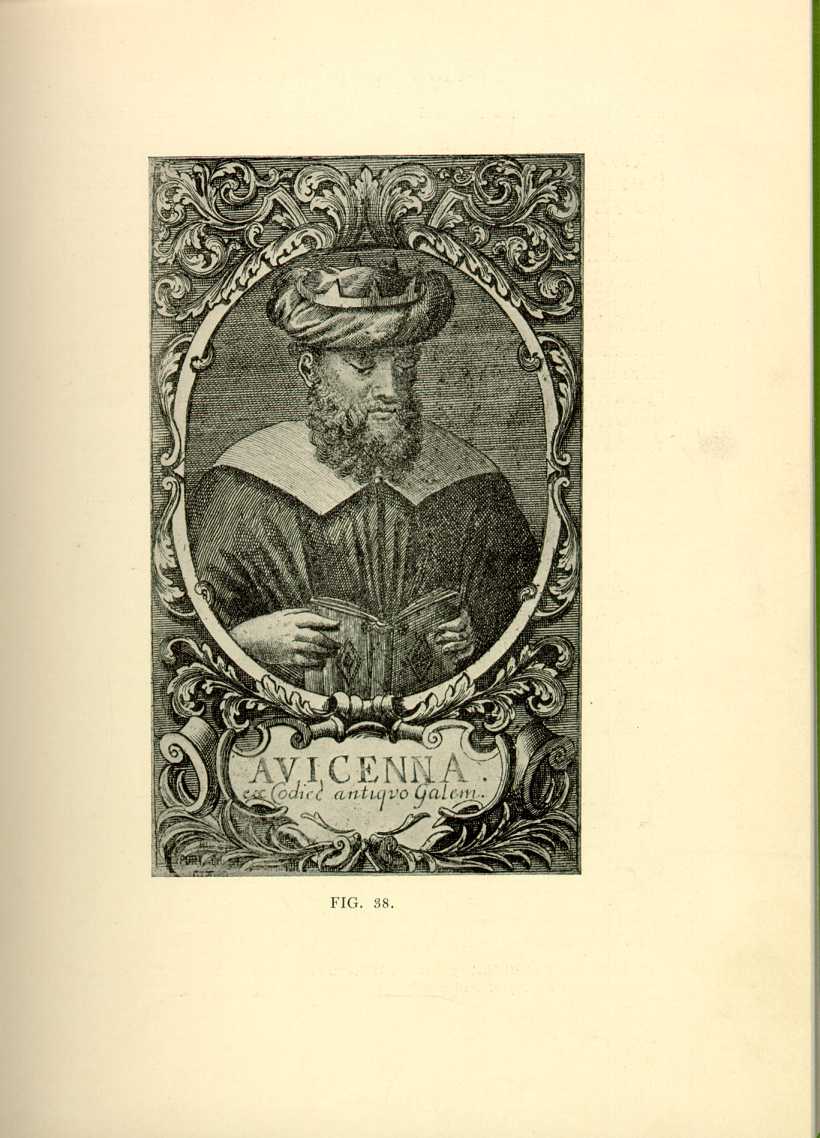
FIG. 38.
[Description: A black and white portrait of Avicenna.]
account of his zeal for study Rhazes was known as the "Experimentator."
The first of the Arabians, known throughout the Middle Ages as the Prince, the rival, indeed, of Galen, was the Persian Ibn Sina, better known as Avicenna, one of the greatest names in the history of medicine. Born about 980 A. D. in the province of Khorasan, near Bokhara, he has left a brief autobiography from which we learn something of his early years. He could repeat the Koran by heart when ten years old, and at twelve he had disputed in law and in logic. So that he found medicine was an easy subject, not hard and thorny like mathematics and metaphysics! He worked night and day, and could solve problems in his dreams. "When I found a difficulty," he says, "I referred to my notes and prayed to the Creator. At night, when weak or sleepy, I strengthened myself with a glass of wine." [80] He was a voluminous writer to whom scores of books are attributed, and he is the author of the most famous medical text-book ever written. It is safe to say that the "Canon" was a medical bible for a longer period than any other work. It "stands for the epitome of all precedent development, the final codification of all Græco-Arabic medicine. It is a hierarchy of laws liberally illustrated by facts which so ingeniously rule and are subject to one another, stay and uphold one another, that admiration is compelled for the sagacity of the great organiser who, with unparalleled power of systematisation, collecting his material from all sources, constructed so imposing an edifice of fallacy. Avicenna, according to his lights, imparted to contemporary medical science the appearance of almost mathematical accuracy, whilst the art of therapeutics, although empiricism did not wholly lack recognition, was deduced as a logical sequence from theoretical (Galenic and Aristotelian) premises. Is it, therefore, matter for surprise that the majority of investigators and practitioners should have fallen under the spell of this consummation of formalism and should have regarded the `Canon' as an infallible oracle, the more so in that the logical construction was impeccable and the premises, in the light of contemporary conceptions, passed for incontrovertible axioms?" [81]
Innumerable manuscripts of it exist: of one of the most beautiful, a Hebrew version (Bologna Library), I give an illustration (Fig. 39).
A Latin version was printed in 1472 and there are many later editions, the last in 1663. Avicenna was not only a successful writer, but the prototype of the successful physician who was at the same time statesman, teacher, philosopher and literary man. Rumor has it that he became dissipated, and a contemporary saying was that all his philosophy could not make him moral, nor all his physic teach him to preserve his health. He enjoyed a great reputation as a poet. I reproduce (Fig. 40) a page of a manuscript of one of his poems, which we have in the Bodleian Library. Prof. A. V. W. Jackson says that some of his verse is peculiarly Khayyamesque,
though he antedated Omar by a century. That "large Infidel" might well have written such a stanza as
I've solved all problems of this world's Estate,
From every snare of Plot and Guile set free,
Each bond resolved, saving alone Death's Fate.
His hymn to the Deity might have been written by Plato and rivals the famous one of Cleanthes.[82] A casual reader gets a very favorable impression of Avicenna. The story of his dominion over the schools in the Middle Ages is one of the most striking in our history. Perhaps we feel that Leclerc exaggerates when he says: "Avicenna is an intellectual phenomenon. Never perhaps has an example been seen of so precocious, quick and wide an intellect extending and asserting itself with so strange and indefatigable an activity." The touch of the man never reached me until I read some of his mystical and philosophical
shape, and surrounded by an unpretentious court. It was restored in 1877, but is again in need of repair. The illustration here shown (Fig. 41) is from a photograph sent by Dr. Neligan of Teheran. Though dead, the great Persian has still a large practice, as his tomb is much visited by pilgrims, among whom cures are said to be not uncommon.
The Western Caliphate produced physicians and philosophers almost as brilliant as those of the East. Remarkable schools of medicine were founded at Seville, Toledo and Cordova. The most famous of the professors were Averroës, Albucasis and Avenzoar. Albucasis was "the Arabian restorer of surgery." Averroës, called in the Middle Ages "the Soul of Aristotle" or "the Commentator," is better known today among philosophers than physicians. On the revival of Moslem orthodoxy he fell upon evil days, was persecuted as a free-thinker, and the saying is attributed to him—"Sit anima mea cum philosophic."
Arabian medicine had certain very definite characteristics: the basis was Greek, derived from translations of the works of Hippocrates and Galen. No contributions were made to anatomy, as dissections were prohibited, nor to physiology, and the pathology was practically that of Galen. Certain new and important diseases were described; a number of new and active remedies were introduced, chiefly from the vegetable kingdom. The Arabian hospitals were well organized and were deservedly famous. No such hospital exists today in Cairo as that which was built by al-Mansur Gilafun in 1283. The description of it by Makrizi, quoted by Neuburger,[84] reads like that of a twentieth century institution with hospital units.
It was in the domain of chemistry that the Arabs made the greatest advances. You may remember that, in Egypt, chemistry had already made considerable strides, and I alluded to Prof. Elliot Smith's view that one of the great leaps in civilization was the discovery in the Nile Valley of the metallurgy of copper. In the brilliant period of the Ptolemies, both chemistry and pharmacology were studied, and it seems not improbable that, when the Arabs took Alexandria in the year 640, there were still many workers in these subjects.
The most famous of those early Arabic writers is the somewhat mythical Geber, who lived in the first half of the eighth century, and whose writings had an extraordinary influence throughout the Middle Ages. The whole story of Geber is discussed by Berthelot in his "La chimie au moyen âge" (Paris, 1896).
The transmission of Arabian science to the Occident began with the Crusades, though earlier a filtering of important knowledge in mathematics and astronomy had reached Southern and Middle Europe through Spain. Among the translators several names stand out prominently. Gerbert, who became later Pope Sylvester II, is said to have given us our present Arabic figures. You may read the story of his remarkable life in Taylor,[85] who says he was "the first mind of his time, its greatest teacher, its most eager learner, and most universal scholar." But he does not seem to have done much directly for medicine.
The Græco-Arabic learning passed into Europe through two sources. As I have already mentioned, Constantinus Africanus, a North African Christian monk, widely travelled and learned in languages, came to Salernum and translated many works from Arabic into Latin, particularly those of Hippocrates and Galen. The "Pantegni" of the latter became one of the most popular text-books of the Middle Ages. A long list of other works which he translated is given by Steinschneider.[86] It is not unlikely that Arabic medicine had already found its way to Salernum before the time of Constantine, but the influence of his translations upon the later Middle Ages was very great.
The second was a more important source through the Latin translators in Spain, particularly in Toledo, where, from the middle of the twelfth till the middle of the thirteenth century, an extraordinary number of Arabic works in philosophy, mathematics and astronomy were translated. Among the translators, Gerard of Cremona is prominent, and has been called the "Father of Translators." He was one of the brightest intelligences of the Middle Ages, and did a work of the first importance to science, through the extraordinary variety of material he put in circulation. Translations, not only of the medical writers, but of an indiscriminate crowd of authors in philosophy and general literature, came from his pen. He furnished one of the first translations of the famous "Almagest" of Ptolemy, which opened the eyes of his contemporaries to the value of the Alexandrian astronomy. [87] Leclerc gives a list of seventy-one works from his hand.
Many of the translators of the period were Jews, and many of the works were translated from Hebrew into Latin. For years Arabic had been the learned language of the Jews, and in a large measure it was through them that the Arabic knowledge and the translations passed into South and Central Europe.
The Arab writer whose influence on mediæval thought was the most profound was Averroës, the great commentator on Aristotle.
Traités mystiques d'Abou Ali al-Hosain b. Abdallah b. Sina ou d'Avicenne par M. A. F. Mehren, Leyden, E. J. Brill, Fasc. I-IV, 1889-1899.
"I have founded this institution for my equals and for those beneath me, it is intended for rulers and subjects, for soldiers and for the emir, for great and small, freemen and slaves, men and women." "He ordered medicaments, physicians and everything else that could be required by anyone in any form of sickness; placed male and female attendants at the disposal of the patients, determined their pay, provided beds for patients and supplied them with every kind of covering that could be required in any complaint. Every class of patient was accorded separate accommodation: the four halls of the hospital were set apart for those with fever and similar complaints; one part of the building was reserved for eye-patients, one for the wounded, one for those suffering from diarrhoea, one for women; a room for convalescents was divided into two parts, one for men and one for women. Water was laid on to all these departments. One room was set apart for cooking food, preparing medicine and cooking syrups, another for the compounding of confections, balsams, eye-salves, etc. The head-physician had an apartment to himself wherein he delivered medical lectures. The number of patients was unlimited, every sick or poor person who came found admittance, nor was the duration of his stay restricted, and even those who were sick at home were supplied with every necessity."—Makrizi.
"In later times this hospital was much extended and improved. The nursing was admirable and no stint was made of drugs and appliances; each patient was provided with means upon leaving so that he should not require immediately to undertake heavy work." Neuburger: History of Medicine, Vol. 1, p. 378.
| CHAPTER III The Evolution of Modern Medicine | ||
